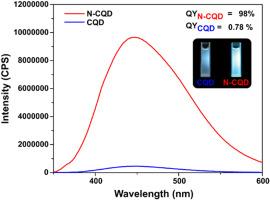生物质氮掺杂碳量子点:快速微波合成及其在体外生物材料和生物成像中的双重应用
IF 4.7
3区 材料科学
Q2 MATERIALS SCIENCE, MULTIDISCIPLINARY
引用次数: 0
摘要
氮掺杂碳量子点(N-CQDs)可以很容易地从广泛的生物质来源的前体,如果皮、种子、蛋白质甚至食物垃圾中合成。生物质天然含有富碳和含氮化合物,既可以作为碳骨架,也可以作为氮掺杂剂。但是,如果这些来源是特定区域特有的,那么在世界其他地区的可再现性和可伸缩性可能会受到限制。为了确保更广泛的可及性和可重复性,利用CQD生产中广泛可用的生物质资源是有利的。此外,用氮掺杂CQDs可以显著提高其光学性质、量子产率和表面功能。因此,本研究以生物质(Morus alba)为原料,通过微波辐照合成碳量子点,得到了溶液中量子产率高(ΦF = 0.98)的氮掺杂碳量子点(N-CQDs)。通过原子力显微镜(AFM)对材料进行了结构和形貌表征,其中一个维度的平均尺寸为4.81 nm。对其光物理性质进行了评价,发现其最大发射波长为449nm。N-CQDs的拉曼光谱显示D和G波段,ID/IG比值为1.04,表明其无序程度较高。透射电镜(TEM)显示,N-CQDs形貌可控,粒径分布较窄(粒径为4.74±2.20 nm),空间分散均匀。采用浸渍法制备丝素染料,获得均匀的染色效果。此外,获得了人脐静脉内皮细胞(HUVEC)的生物图像,并对其细胞毒性进行了评估,获得了95%以上的细胞存活率。这种材料可以在两种类型的激光下观察生物材料和细胞染色,再加上其出色的细胞活力,突出了其潜在的生物医学应用。本文章由计算机程序翻译,如有差异,请以英文原文为准。

Nitrogen-doped carbon quantum dots from biomass: Fast microwave synthesis and dual application in biomaterials and bioimaging in vitro
Nitrogen-doped carbon quantum dots (N-CQDs) can be readily synthesized from an extensive range of biomass-derived precursors such as fruit peels, seeds, proteins and even food waste. Biomass naturally contains carbon-rich and nitrogen-containing compounds, which can serve as both the carbon skeleton and the nitrogen dopant. However, when these sources are endemic to specific regions, reproducibility and scalability might be limited in other parts of the world. To ensure broader accessibility and reproducibility, it is advantageous to use widely available biomass resources from CQD production. Moreover, doping CQDs with nitrogen can significantly enhance their optical properties, quantum yield, and surface functionality. Thus, in this work, carbon quantum dots were synthesized from biomass (Morus alba) via microwave irradiation to obtain a nitrogen-doped carbon quantum dots (N-CQDs) with a high quantum yield in solution (ΦF = 0.98). The material was structurally and morphologically characterized by AFM obtaining an average size of 4.81 nm in one of its dimensions. Its photophysical properties were evaluated showing a maximum emission at 449 nm. Raman spectra of N-CQDs showed D and G bands with an ID/IG ratio of 1.04, indicating a high degree of disorder. Transmission electron microscopy (TEM) showed N-CQDs with controlled morphology, relatively narrow size distribution (particle diameter of 4.74 ± 2.20 nm), and spatially uniform dispersion. This material was used as a dye for silk fibroin by immersion method obtaining a uniform staining. In addition, bioimages of Human Umbilical Vein Endothelial Cells (HUVEC) were obtained and their cytotoxicity was evaluated obtaining a cell viability higher than 95 %. This material allows observing the biomaterial and cell staining under 2 types of lasers which, together with its excellent cell viability, highlight its potential biomedical applications.
求助全文
通过发布文献求助,成功后即可免费获取论文全文。
去求助
来源期刊

Materials Chemistry and Physics
工程技术-材料科学:综合
CiteScore
8.70
自引率
4.30%
发文量
1515
审稿时长
69 days
期刊介绍:
Materials Chemistry and Physics is devoted to short communications, full-length research papers and feature articles on interrelationships among structure, properties, processing and performance of materials. The Editors welcome manuscripts on thin films, surface and interface science, materials degradation and reliability, metallurgy, semiconductors and optoelectronic materials, fine ceramics, magnetics, superconductors, specialty polymers, nano-materials and composite materials.
 求助内容:
求助内容: 应助结果提醒方式:
应助结果提醒方式:


